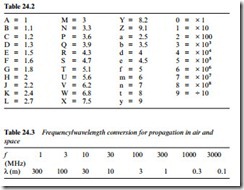DECIBEL CONVERSION
Field signal strengths for r.f. transmissions are often given in micro- volts per metre (μV/m) of free space. The boundary of the service area of a UHF transmitter is taken to be the 60 dBμV/m contour, corresponding to 1 mV/metre. Table 24.4 converts dBμV/m to voltage. Because the voltage given is an open-circuit one at an untuned
1 metre rod, several factors must be taken into account in calculat- ing a figure for signal strength at the aerial socket, as follows. Field strength is related to signal strength by the factor λ/π where λ is the wavelength. Average figures are 0.2 (–14 dB) in band IV; 0.15 (–16 dB) at the lower end of Band V; and 0.12 (–18 dB) at the top of Band V. Next must be added the gain of the aerial, typically 6 dB for an 18-element Yagi type, 10 dB for an 8-element Yagi and 13 dB for an 18-element Yagi. Account must also be taken of the loss in the downlead – 10 metres of ‘low-loss’ coaxial cable introduces a loss of about 3 dB. Finally, allowance must be made for the fact that a practical feeder is terminated in 75 Ω, rather than open-circuit, and so a further loss of 6 dB is incurred. Table 24.5 gives two examples of widely different situations, in each case calculating the signal strength at the receiver aerial socket.
Table 24.6 gives an accurate dB conversion chart applicable to r.f. levels as well as video and audio baseband signals. Standard levels for signal interchange between equipment are composite video 1 V p-p in 75 Ω; CVBS 1.235 V p-p in 75 Ω; audio 0 db = 0.775 V in 600 Ω.
CONNECTOR PINNING
All contemporary videorecorders and many TV sets have baseband video and audio input and output sockets. The standard pin configuration for several types of plug/socket are given in Fig. 24.2 (on page 480).
ABBREVIATIONS
Table 24.7 lists abbreviations used in service data and specifications (page 490).
